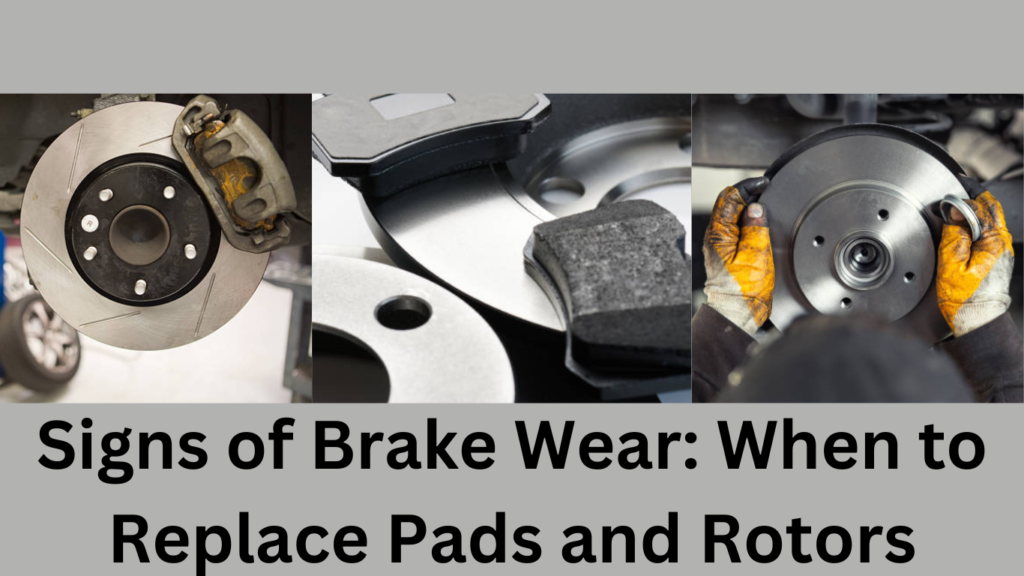Introduction
As a car enthusiast, you know that staying on top of vehicle maintenance is crucial for both safety and performance. Among the various components that need regular attention, brake wear stand out as a paramount concern. A well-maintained brake system ensures not only your safety but also the longevity of your car. In this guide, we’ll delve into the signs of brake wear, helping you understand when it’s time to replace those essential components – brake pads and rotors.
The Importance of Maintaining Your Brakes
Before we dive into the signs of brake wear, let’s take a moment to emphasize just how crucial your brakes are. Whether you’re cruising down the highway or navigating busy city streets, the ability to stop your vehicle safely and efficiently is paramount. Neglecting brake maintenance can lead to costly repairs, reduced stopping power, and, worst of all, accidents.
Your brake system consists of several components, but two of the most critical ones are the brake pads and rotors. The brake pads apply friction to the rotors, creating the necessary force to slow or stop your vehicle. Over time, both these components wear down, and understanding when to replace them is essential for maintaining optimal braking performance.
Signs of Brake Pad Wear
- Squeaking or Squealing Noises: One of the earliest signs of brake pad wear is a high-pitched squeaking or squealing noise when you apply the brakes. This sound is usually caused by a wear indicator built into the brake pad. When you hear it, it’s time to start thinking about a replacement.
- Reduced Braking Performance: If you notice that your car takes longer to stop or that the brakes feel less responsive, it’s a clear indication that your brake pads are nearing the end of their lifespan. Don’t wait for the problem to worsen; replace them promptly.
- Vibration or Pulsation: If you feel a pulsation or vibration in the brake pedal when you apply the brakes, it could be due to uneven wear on the brake pads. This issue not only affects braking performance but can also lead to damage to other brake components if left unaddressed.
- Thin Brake Pads: You can physically inspect your brake pads through the spokes of your wheel. If the pads appear to be less than a quarter of an inch thick, it’s time for a replacement.
Signs of Rotor Wear
- Deep Grooves or Scoring: Examine your brake rotors for deep grooves or scoring. These can develop over time due to the friction between the brake pads and the rotors. If you can feel these grooves with your fingernail or they are visibly pronounced, it’s time to replace the rotors.
- Uneven Wear: If you notice uneven wear on the rotor’s surface, it can lead to brake pulsation and reduced braking performance. Replacing the rotors is essential to maintain a smooth and efficient braking system.
- Heat Spots: Heat spots on the rotor’s surface can indicate overheating, which can lead to warping. If you see discolored or blueish areas on the rotor, it’s a sign that they’ve been subjected to excessive heat and need replacing.
- Thickness Variation: Use a micrometer to measure the thickness of your rotors at multiple points. If there’s a significant variation in thickness across the rotor, it’s a clear sign of wear and a potential safety hazard.
Knowing When to Replace Both
While understanding the individual signs of brake pad and rotor wear is essential, it’s equally important to recognize when it’s time to replace both components. Generally, it’s recommended to replace the brake pads and rotors together to ensure consistent performance.
- Mileage and Time: As a rule of thumb, consider replacing your brake pads and rotors every 50,000 miles or as recommended in your vehicle’s manual. However, factors like driving habits and terrain can significantly affect wear rates.
- Comprehensive Inspection: Periodically inspect your brake pads and rotors as part of routine maintenance. If any of the signs mentioned earlier are evident, it’s time to replace both components.
- Brake Fluid Replacement: When you change your brake fluid, it’s a good time to assess the condition of your brake pads and rotors. Old or contaminated brake fluid can lead to accelerated wear, so regular fluid changes can help extend the life of these components.
DIY Brake Replacement vs. Professional Service
Now that you’re familiar with the signs of brake wear, you might be wondering whether to replace them yourself or seek professional service. Here are some factors to consider:
DIY Brake Replacement:
- Cost Savings: Replacing brake pads and rotors yourself can save you money on labor charges.
- Satisfaction: For car enthusiasts, working on your vehicle can be a satisfying experience.
- Knowledge Gain: Learning how to replace brakes can enhance your automotive knowledge and skills.
Professional Brake Service:
- Expertise: Mechanics have the experience and expertise to ensure a proper installation, reducing the risk of mistakes.
- Warranty: Many shops offer warranties on parts and labor, providing peace of mind.
- Time Saving: Professional service is often quicker than DIY, minimizing downtime for your vehicle.
Ultimately, the choice between DIY and professional service depends on your comfort level, time, and budget.
Brake Pad and Rotor Materials
When it comes to replacing your brake pads and rotors, you’ll encounter different materials, each with its advantages:
Brake Pad Materials:
- Organic: Organic brake pads are quiet and provide smooth braking. They’re an excellent choice for daily driving but may wear out faster than other materials.
- Semi-Metallic: These pads offer improved braking performance and durability but may produce more dust and noise.
- Ceramic: Ceramic brake pads are known for their quiet operation, low dust production, and excellent braking performance. They tend to last longer but can be more expensive.
Rotor Materials:
- Cast Iron: Most OEM rotors are made of cast iron. They’re cost-effective and provide reliable performance for everyday driving.
- Carbon Composite: These rotors offer improved heat dissipation and reduced weight compared to cast iron. They’re often found on performance and high-end vehicles.
- Drilled and Slotted: These rotors have holes and slots designed to dissipate heat more effectively and prevent brake fade. They’re ideal for aggressive driving but may wear out faster.
Brake Replacement Tips
Whether you choose to replace your brakes yourself or opt for professional service, here are some tips to ensure a smooth replacement process:
- Safety First: Always prioritize safety. Use jack stands, wear protective gear, and follow proper procedures.
- Cleanliness: Keep the brake components clean and free of contaminants to ensure optimal performance.
- Bedding In: After replacing your brake pads and rotors, perform a proper bedding-in procedure to ensure they work effectively and last longer.
- Quality Parts: Invest in high-quality brake pads and rotors from reputable manufacturers to ensure reliability and longevity.
Conclusion
Maintaining your brakes is not just a matter of convenience; it’s a critical aspect of vehicle safety and performance. Understanding the signs of brake wear, knowing when to replace brake pads and rotors, and choosing the right materials for your driving needs are all essential steps in keeping your vehicle in top condition.
By staying vigilant and addressing brake wear promptly, you can enjoy peace of mind on the road, knowing your brakes are up to the task when you need them most. Whether you’re a seasoned car enthusiast or simply want to ensure your daily commute remains safe, your brakes are one aspect of your vehicle you should never neglect. So, keep an eye out for those signs of wear, and when it’s time for replacement, make the smart choice for your car’s safety and performance.



